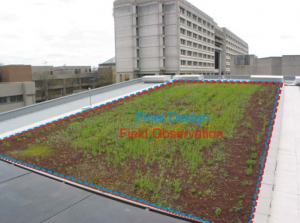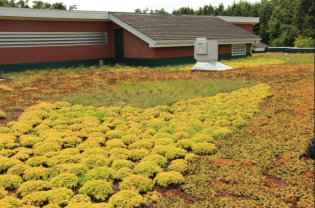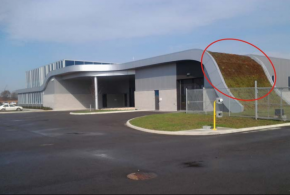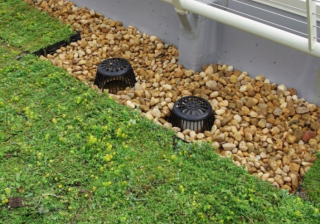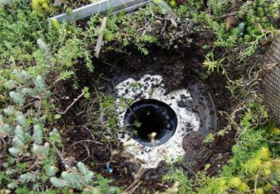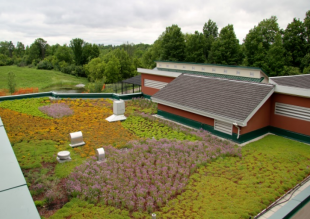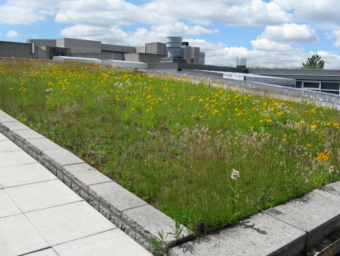Inspection and Maintenance: Green Roofs
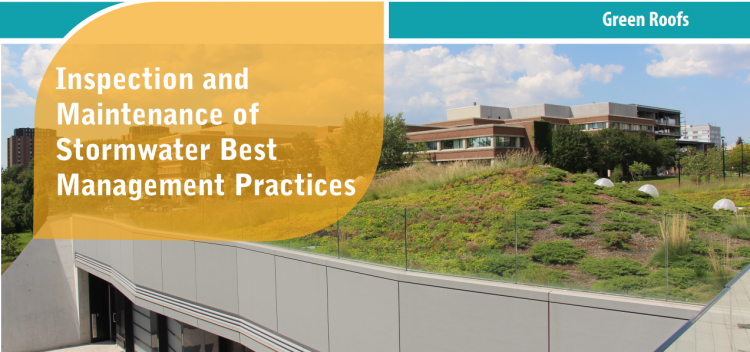
Overview[edit]
Green roofs are engineered rooftop design features that allow the growth of vegetation on rooftops and have numerous benefits. These LID BMPs can also be referred to as vegetated roofs, rooftop gardens or eco-roofs. A green roof acts like a lawn, meadow or garden by intercepting and absorbing a portion of the rainwater or snowmelt that falls on it. The typical layers of a green roof (in ascending order from the roof surface) include a water-proofing membrane, drainage layer, lightweight growing media layer and the vegetation. Excess water that is not absorbed by the growing media or vegetation is collected by the underlying drainage layer, directed to outlet structures and conveyed via the roof drainage system to another BMP or the municipal storm sewer system. A portion of the water absorbed by green roofs is returned to the atmosphere by evaporation and transpiration by plants. Green roofs are typically designed to retain precipitation from small to medium-sized (e.g., 5 to 25 mm rainfall depth) storm events. Overflow outlets are necessary to safely convey flows from major storm events.
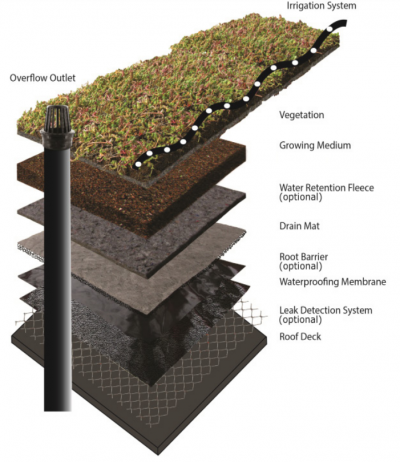
Some of the benefits of green roofs include:
- The ability to reduce the quantity of pollutants and runoff being discharged to municipal storm sewers and receiving waters (i.e., rivers, lakes and wetlands);
- Growing media and plants retain pollutants deposited from the atmosphere and reduce metals and other pollutants from conventional roof materials transported by runoff;
- Improve the energy efficiency of the building due to their insulating properties;
- Reduce the urban heat island effect;
- Can provide food and shelter for pollinators;
- Can provide aesthetic value as attractive landscaped features.
Key components of Underground Infiltration Systems to pay close attention to are the:
Associated Practices[edit]
- Intensive green roofs contain greater than 15 cm depth of growing media, can be planted with deeply rooted plants (e.g., shrubs and trees) and can be designed to handle pedestrian traffic.
- Extensive green roofs consist of a thinner growing media layer (15 cm depth or less) and are typically planted with.
- Blue roofs are systems that temporarily capture rainwater using the roof as storage and allow it to evaporate and/or to be used for non-potable requirements (i.e. irrigation, toilet flushing, truck washing) and ultimately offset potable water demands.
Inspection and Testing Framework[edit]
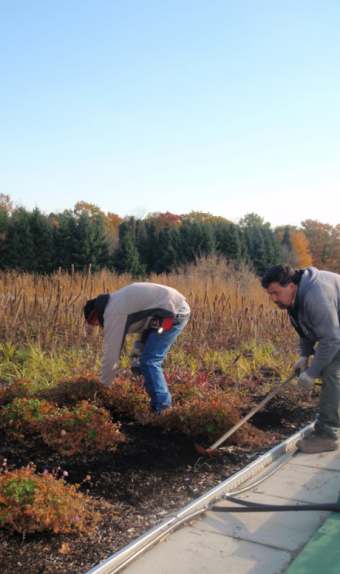
Component |
Indicators |
Construction Inspection |
Assumption Inspection |
Routine Operation Inspection |
Verification Inspection |
|---|---|---|---|---|---|
| Perimeter | |||||
| BMP dimensions | x | x | x | ||
| Growing medium/filter bed | |||||
| Green roof structural integrity | x | x | x | ||
| Standing water | x | x | x | ||
| Filter bed erosion | x | x | |||
| Vegetation | |||||
| Vegetation cover | x | x | x | x | |
| Vegetation condition | x | x | |||
| Vegetation composition | x | x | x | ||
| Overflow outlets | |||||
| Overflow outlet obstruction | x | x | x | x |
Component |
Indicators |
Construction Inspection |
Assumption Inspection |
Routine Operation Inspection |
Verification Inspection | |
|---|---|---|---|---|---|---|
| Testing Indicators | ||||||
| Soil characterization testing | x | x | (x) | |||
| Green roof irrigation system testing | x | x | x | |||
| Green roof leak detection testing | x | x | ||||
| Note: (x) denotes indicators to be used for Performance Verification inspections only (i.e., not for Maintenance Verification inspections) | ||||||
Construction Inspection Tasks[edit]
Construction inspections take place during several points in the construction sequence, specific to the type of LID BMP, but at a minimum should be done weekly and include the following:
- During site preparation, prior to BMP installation to ensure the roof structure is ready for green roof construction work and confirm that BMP layout area matches approved design drawings and that construction materials meet design specifications
- After installation of leak detection system (if applicable) to ensure it was done properly
- At installation of water-proofing membrane, prior to installation of root barrier, drainage layer and overflow outlets to ensure it was done properly and to confirm that slopes are acceptable
- After installation of root barrier, drainage layer (including filter fabric/layer) and overflow outlets, prior to installation of growing medium and plants to ensure it was done properly and confirm that depth and slopes are acceptable
- After installation of growing medium layer and plants to ensure it was done properly and to confirm depth, slopes and elevations at overflow outlets are acceptable; After installation of irrigation system to confirm system is functioning
- Prior to hand-off points in the construction sequence when the contractor responsible for the work changes (i.e., hand-offs between the building and green roof installation contractors)
- After every large storm event (e.g., 15 mm rainfall depth or greater) to ensure roof drainage or flow diversion devices are functioning and adequately maintained. You can also download and print the table here
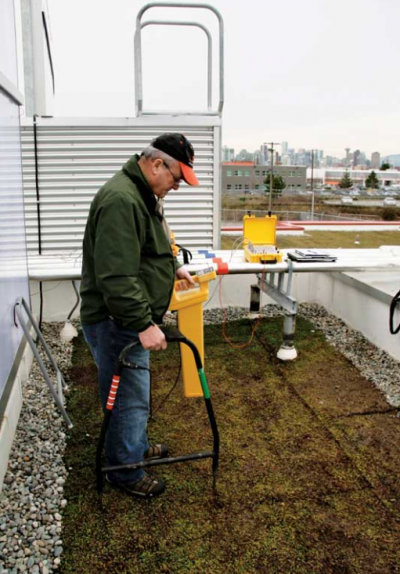
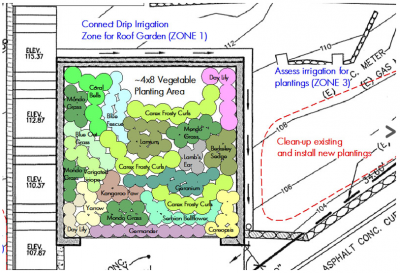
Construction Sequence Step & Timing |
Inspection Item |
Observations* |
|---|---|---|
| Site Preparation - During site preparation, prior to BMP installation | Ensure the roof structure is ready for green roof construction work | |
| BMP layout area and dimensions match approved design drawings | ||
| CDA is stabilized or runoff is diverted around BMP layout area | ||
| Construction materials have been confirmed to meet design specifications | ||
| Leak detection System - After installation of leak detection system (if applicable), prior to installation of water-proofing membrane | Quality control check leak detection system installation | |
| Water Proofing Membrane – After installation of waterproofing membrane, prior to installation of root barrier, drainage layer and overflow outlets | Quality control check membrane installation | |
| Confirm that slopes conform with approved design drawings | ||
| Root barrier / Drainage layer and Overflow outlets – After installation of root barrier, drainage layer (including filter fabric) and overflow outlets, prior to installation of growing medium layer and plants | Quality control check root barrier and drainage layer installations | |
| Installation of drainage layer (e.g., depth and slope) is acceptable | ||
| Installations of overflow outlets (e.g., elevation and slope) are acceptable | ||
| Filter bed – After installation of filter bed (growing medium layer and plants) | Quality control check installation of any structural components of growing medium layer (if applicable) | |
| Installation of growing medium (e.g., depth, elevations at overflow outlets) is acceptable | ||
| Growing medium is free of ruts, local depressions | ||
| Planting material meets approved planting plan specifications (plant types and quantities) | ||
| Quality control check installation of erosion matting/protection (if applicable) | ||
| Irrigation System - After installation of irrigation system | Confirm installation is acceptable and system is functioning (through testing) |
Routine Maintenance - Key Components and I&M Tasks[edit]
Regular inspections (twice annually, at a minimum) done as part of routine maintenance tasks over the operating phase of the BMP life cycle to determine if maintenance task frequencies are adequate and determine when rehabilitation or further investigations into BMP function are warranted.
The table below describes routine maintenance tasks for green roofs, organized by BMP component, along with recommended minimum frequencies. It also suggests higher frequencies for certain tasks that may be warranted for BMPs located in highly visible or high pedestrian traffic locations or intensive green roofs featuring shrubs, trees and a wider variety of vegetation types. Tasks involving removal of trash, debris and weeding/trimming or replacement of dead plants may need to be done more frequently in such contexts. For further guidance on maintenance of vegetation cover on green roofs, refer to ASTM D2400/E2400M-06 Standard Guide for Selection, Installation and Maintenance of Plants for Green Roof Systems (ASTM International, 2015)[4]
Individuals conducting vegetation maintenance and in particular, weeding (i.e., removal of undesirable vegetation), should be familiar with the species of plants specified in the planting plan and experienced in plant identification and methods of removing/controlling noxious weeds. Key resources on these topics are provided below at the links provided:
- Agriculture and Agri-food Canada’s Weed Info database
- Ontario Ministry of Agriculture, Food and Rural Affairs’ Ontario Weed Gallery
- Ontario Ministry of Agriculture, Food and Rural Affairs’ Noxious Weeds In Ontario list
- Ontario Invasive Plant Council’s Quick Reference Guide to Invasive Plant Species
- Oregon State University Stormwater Solutions, 2013, Field Guide: Maintaining Rain Gardens, Swales and Stormwater Planters, Corvallis, OR.
- Plants of Southern Ontario (book), 2014, by Richard Dickinson and France Royer, Lone Pine Publishing, 528 pgs.
- Weeds of North America (book), 2014, by Richard Dickinson and France Royer, University of Chicago Press, 656 pgs.
| Component | Description | Inspection & Maintenance Tasks | (Pass) Photo Example | (Fail) Photo Example |
|---|---|---|---|---|
| Perimeter |
Separates the green roof from the roof edges and other structures; kept clear of vegetation and natural debris as a fire prevention measure. Parapets or other wind break structures may also be present around the perimeter to help prevent wind scour of growing media. |
|
||
| Growing medium/filter bed |
Flat or gently sloping area covered by growing medium and a mixture of plants. Growing medium varies according to the green roof system or product but is generally designed to be porous and lightweight with adequate fertility and moisture retention to support plant growth while maintaining drainage of excess water within a few hours after a storm or snowmelt event. May be covered by matting/other erosion control product to prevent rain/wind scour while plantings are becoming established. |
|
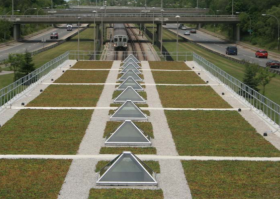 Although permeable pavers are generally considered pretreatment for other BMPs in a treatment train system, using eavestrough screens can act as pretreatment as they don't add to sediment build up and accumulation on the paver surface. (Photo Source: Guertin, 2010)[5] |
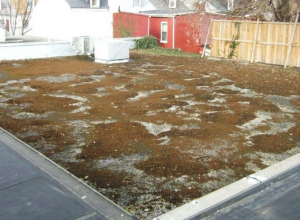 Build up of leads, sediment and leaf detritus in an eavestrough downspout disconnection leading to a permeable pavement surface. If not cleaned regularly this can lead to clogged pores between the pavers reducing the infiltration rate where the downspout deposits water onto the feature. (Photo Source: My Gutter Pro, 2021)[6] |
| Vegetation |
Plants should be tolerant of the harsh conditions prevalent on rooftops. Use of a wide variety of plants may improve resilience but complicates maintenance and may require staff or contractors trained in horticulture |
|
||
| Overflow Outlet |
Flows exceeding the storage capacity of the BMP are conveyed to an adjacent drainage system via an overflow outlet structure and the roof drainage system. |
|
||
| Irrigation System |
Most green roofs will require watering over their operating life cycle, especially during the first 2 months. Systems can range from simple hose bibs, garden hoses and sprinklers to intelligent automated systems that schedule watering based on weather forecasts and cistern water levels. |
|
||
| Protective layers |
May be one or two layers; designed to protect the roof deck from water damage, including a waterproofing membrane, a root barrier that protects the water-proofing membrane from root penetration and degradation by microbial activity. |
|
- ↑ 1.0 1.1 1.2 TRCA. 2018. Fact Sheet - Inspection and Maintenance of Stormwater Best Management Practices: Green Roofs. https://sustainabletechnologies.ca/app/uploads/2018/02/Green-Roofs-Fact-Sheet.pdf
- ↑ Construction Canada. 2012. Waterproofing considerations for green roofs. Photo source: Detec Systems. 1 March 2012. Accessed August 8 2022. https://www.constructioncanada.net/waterproofing-considerations-for-green-roofs/2/
- ↑ O’Connell Landscape. 2010. FROM THE DRAWING BOARD: MILL VALLEY & CORTE MADERA PLANTINGS. Authored 13 January 2010. Accessed 08 August 2022. https://oclandscape.com/ocblog/from-the-drawing-board-mill-valley-corte-madera-plantings/
- ↑ ASTM International. 2015. Standard Guide for Selection, Installation, and Maintenance of Plants for Green Roof Systems. Designation: E 2400 – 06. http://hydro.engr.scu.edu/files/green_roof/ASTM_E2400-06.pdf
- ↑ Guertin, M. 2010. Simple Screen Gutter Guards Better Than Pro-Installed Systems (and way cheaper). Fine Homebuilding - The Daily Fix. Accessed July 17 2022. https://www.finehomebuilding.com/2010/08/17/simple-screen-gutter-guards-better-than-pro-installed-systems-and-way-cheaper
- ↑ My Gutter Pro. 2021. Clogged Downspout : Causes and Solutions. 10 April 2021. Accessed July 19 2022. https://mygutterpro.com/downspout-clog/
